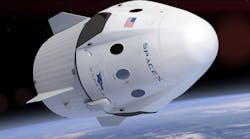I remember hearing of SpaceX a few years ago as a company that privatized launching of spacecraft into Earth’s orbit and beyond. Hydraulics is still used extensively for essential flight-control functions in commercial and military aircraft rather than just for auxiliary functions, and also in spacecraft.
Hydraulics remains the technology of choice to control most critical flight-control surfaces, such as ailerons, elevators, rudders, flaps, and others—and with good cause. Hydraulic actuators can provide higher force, torque, and power in a lighter and more compact package than their electromechanical counterparts while also providing precise and repeatable position and speed control.
But let’s get back to SpaceX, a company founded in 2002 to design, manufacture, and launch advanced rockets and spacecraft. SpaceX intends to revolutionize space technology and has established an ultimate goal of enabling people to live on other planets. A while back I received an inquiry from an engineer at SpaceX. He wanted to know if I could provide him with an article from our December 1963 issue. The article reviewed the hydraulics for the gimbal (steering) system of the Saturn V rocket. The Saturn V was used for NASA’s Apollo missions and was the tallest, heaviest, and most powerful rocket ever launched. It had five engines, capable of producing total thrust of 7.5 million lb.
My reply was that, yes, I have a copy of the issue, and I could scan the pages and email them to him as a single, multi-page PDF. He asked if there was a charge, and I said no, but I did want to know one thing in return. Why on earth would an engineer at SpaceX want to read an article published more than 50 years ago, going back almost to the Kennedy administration? (In fact, considering how much lead time was involved in putting out magazines back then, the article would’ve been written while JFK was still alive.)
He explained that because the Saturn V was designed in the 1960s, all the technical literature back then was in print. In the many years since, most of this material was either disposed of or filed away somewhere and difficult to access. True, the article is filed in our archive, but the archive (going all the way back for our first issue from 1948) is within easy reach of my desk.
Naturally, I couldn’t resist reading the article myself. It describes the “fueldraulic” gimbal system of the Saturn V. Fueldraulic refers to the type of hydraulic fluid the system uses: rocket fuel. As with any aerospace application, weight is second only to safety. So rather than steering each of the rocket’s nozzles (the gimbal system) using a dedicated hydraulic system, the Saturn V routes rocket fuel (similar to kerosene) from a fuel pump to hydraulic valves and actuators. Spent fluid is then routed to the engines, rather than to a reservoir.
The article is an interesting read and a testament to the innovative use of powering the hydraulic system from something other than a conventional power. And who’s to say this innovation couldn’t still find application in some of today’s applications? We’ve posted the article, complete with graphics, onto our website.

